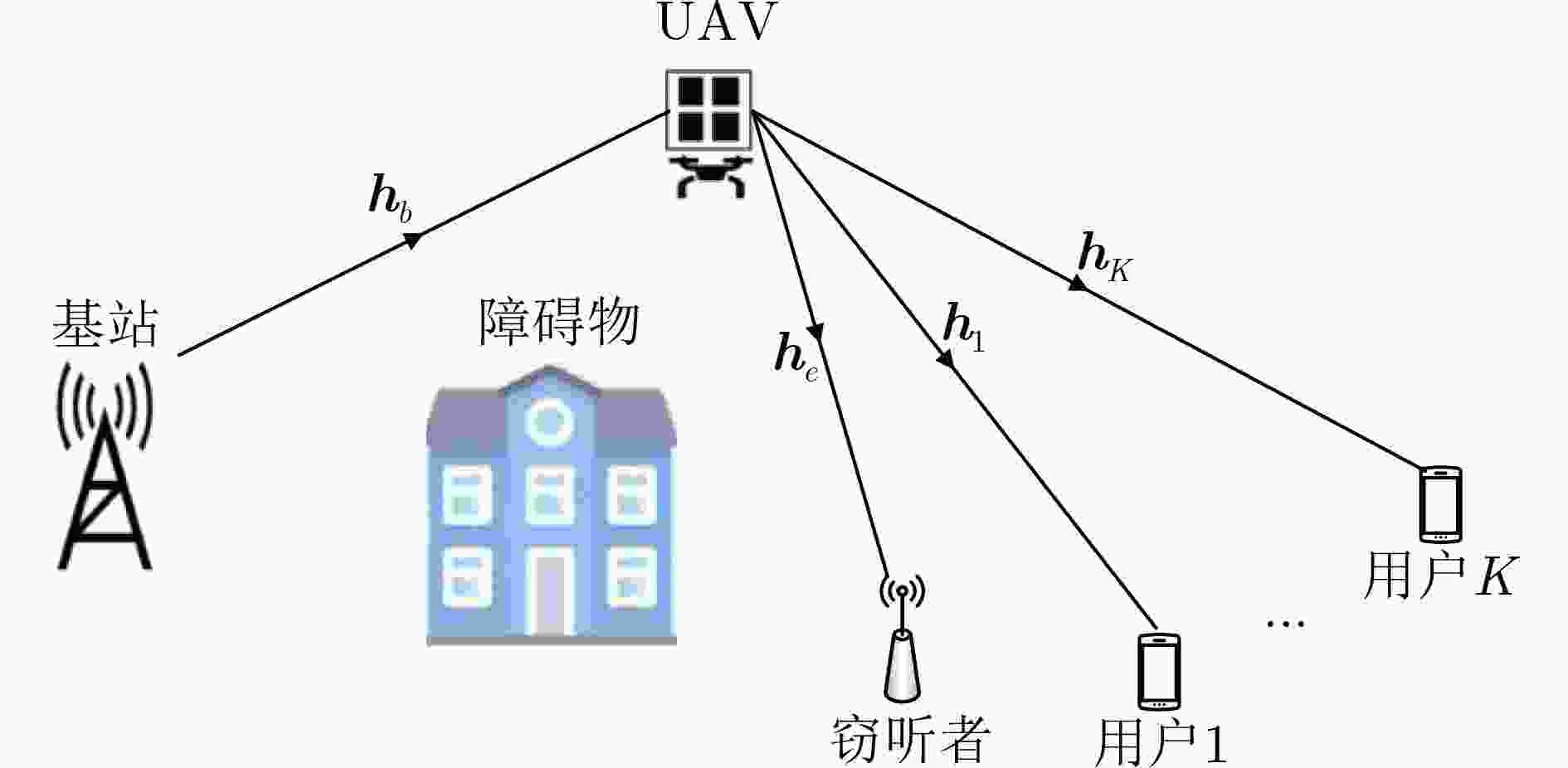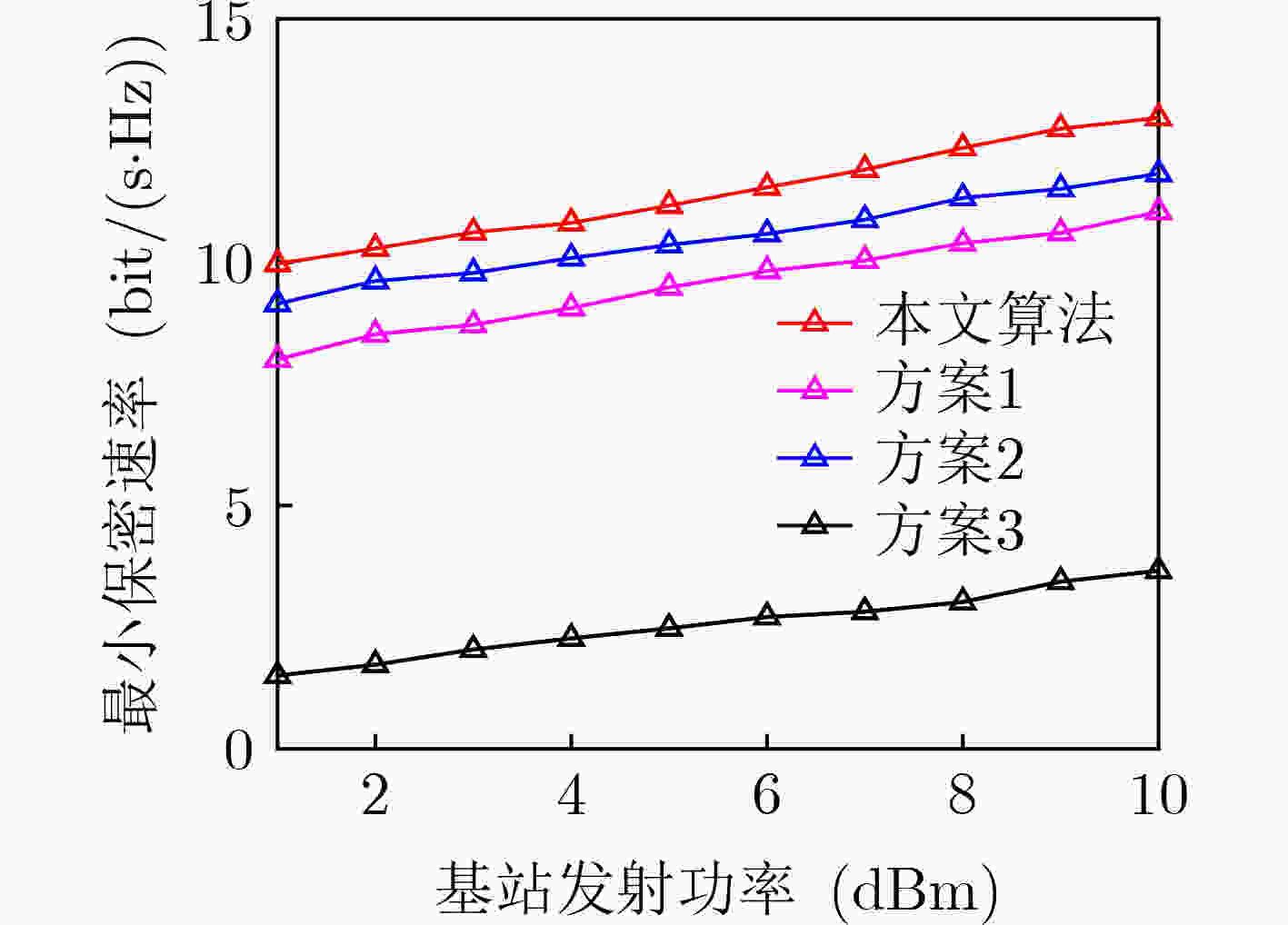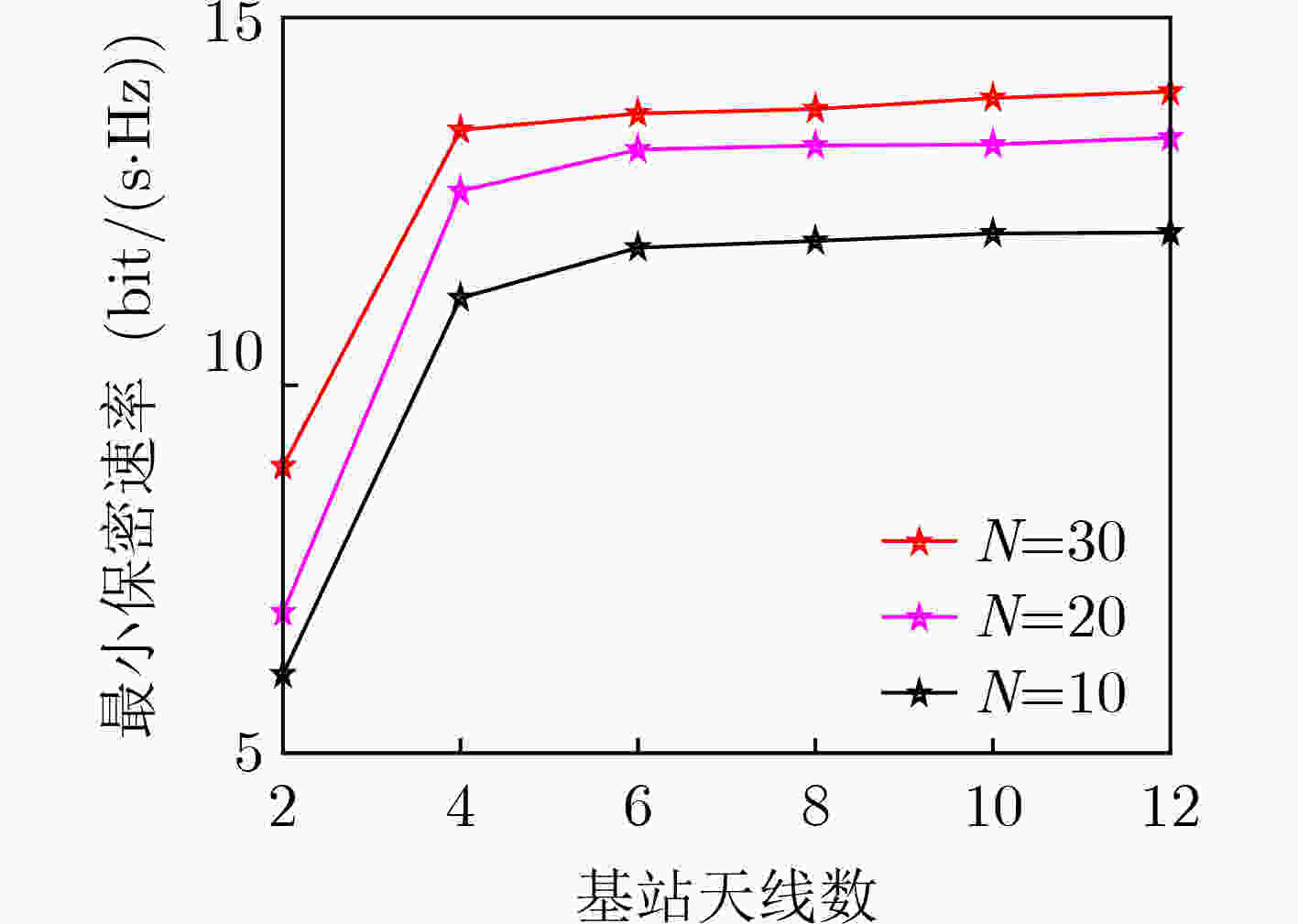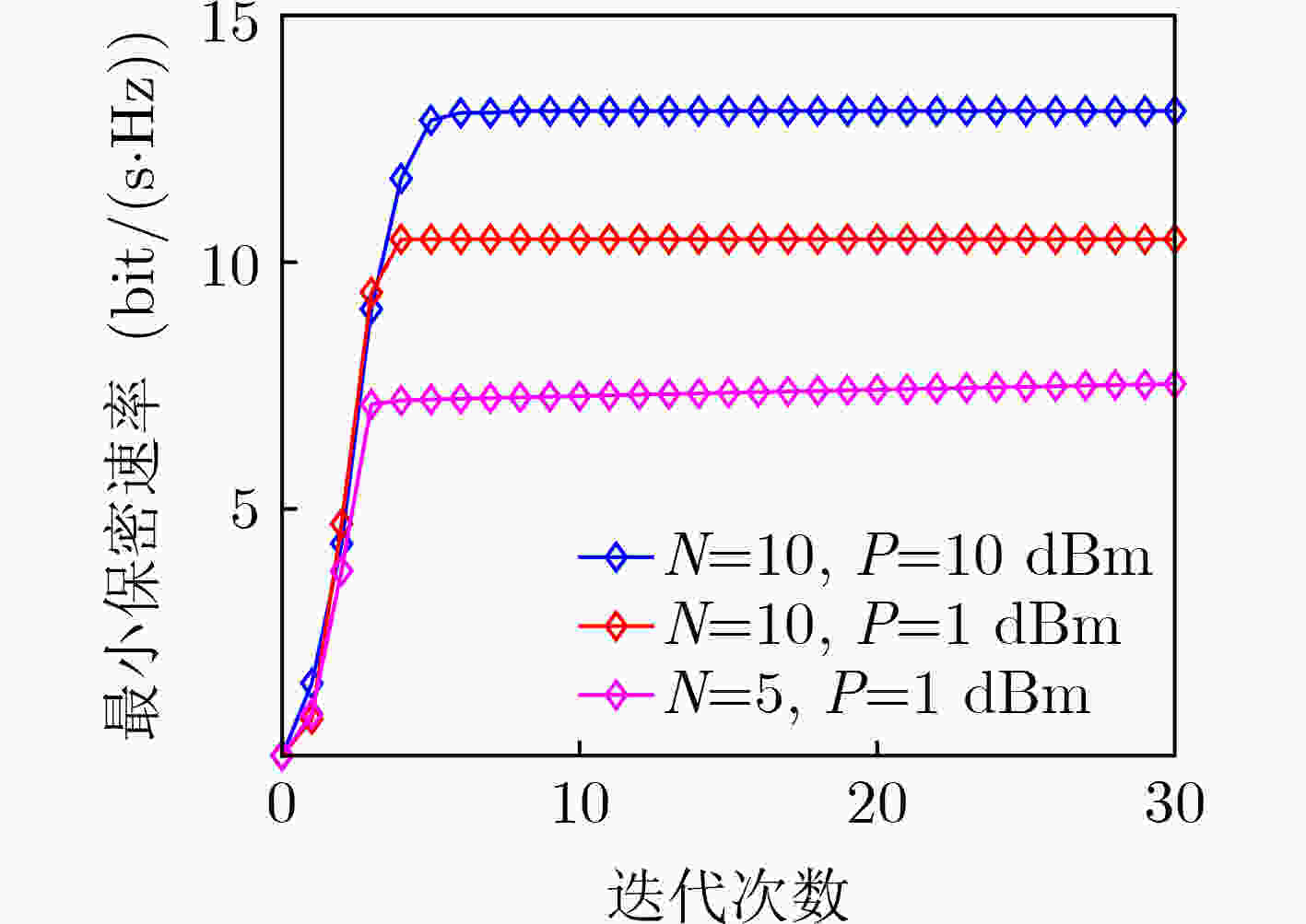Secure Communication Method Based on Intelligent Reflection Surface Assisted UAV Relay System
-
摘要: 为了提高无人机中继系统的安全通信性能,解决无线信道受障碍物遮挡问题,该文提出一种基于智能反射面(IRS)辅助的无人机(UAV)中继系统安全通信方法。在所提方法中,通过联合优化UAV的位置、基站波束成形和IRS相移,最大化系统的最小保密速率。为了解决这个复杂的非凸优化问题,该文将原问题分解为UAV位置优化子问题、波束成形和IRS相移优化两个子问题。使用1阶泰勒展开处理优化问题中的非凸项,然后提出一种交替优化的算法进行求解。仿真结果表明该文提出的算法能提高系统的最小保密速率,并且具有良好的收敛性。Abstract: To improve the security of wireless transmission system and solve the problem that wireless channel is easily blocked by obstacles, a secure communication method based on an Intelligent Reflecting Surface (IRS) assisted Unmanned Air Vehicle (UAV) relay system is proposed. In the proposed method, the minimum-secrecy are maximized by jointly optimizing the position of UAV, beamforming at base station and phase shifts of IRS. To solve this complicated non-convex optimization problem, the original problem is divided into UAV position optimization sub-problem, beamforming and IRS’s phase shifts optimization sub-problem. The first order Taylor expansion method is applied to handle the non-convex terms of the optimization problems. Then, an alternate optimization algorithm is proposed to solve the problem. The simulation results shows that the proposed algorithm can improve the minimum-secrecy rate, and its convergence is well.
-
表 1 优化过程
初始化参数:${{\boldsymbol{W}}^{(0)}},{{\boldsymbol{v}}^{(0)}}$ 收敛精度$\varepsilon \ge0$,迭代次数$l = 0$,最大
迭代次数${L_{\max }}$;(1) While$\left| {c_{}^{(l)} - c_{}^{(l - 1)}} \right| \ge\varepsilon $或$l < {L_{\max }}$do (2) 迭代次数$ l = l + 1 $; (3) 设置${\boldsymbol{W}} = {{\boldsymbol{W}}^{(l - 1)}},{\boldsymbol{v}} = {{\boldsymbol{v}}^{(l - 1)}}$求解问题式(22)确定无人机位
置${\boldsymbol{w}}_{\text{u}}^{(l)}$;(4) 设置${{\boldsymbol{w}}_{\text{u}}} = {\boldsymbol{w}}_{\text{u}}^{(l)},{\boldsymbol{v}} = {{\boldsymbol{v}}^{(l - 1)}}$求解问题式(32)得到波束成形向
量优化值${{\boldsymbol{W}}^{(l)}}$;(5) 设置${{\boldsymbol{w}}_{\text{u}}} = {\boldsymbol{w}}_{\text{u}}^{(l)},{\boldsymbol{W}} = {{\boldsymbol{W}}^{(l)}}$求解问题式(33)得到IRS相移优
化值${{\boldsymbol{v}}^{(l)}}$;
(6) 更新最小保密速率$c_{}^{(l)}{\text{ = }}\mathop {\min }\limits_{\forall k} \left\{ {R_k^{(l)} - R_{{\text{e}},k}^{(l)}} \right\}$;(7) End While -
[1] 吴宣利, 许智聪, 王禹辰, 等. 基于信道相关性的物理层安全性能分析[J]. 通信学报, 2021, 42(3): 65–74.WU Xuanli, XU Zhicong, WANG Yuchen, et al. Performance analysis of physical layer security based on channel correlation[J]. Journal on Communications, 2021, 42(3): 65–74. [2] 任品毅, 唐晓. 面向5G的物理层安全技术综述[J]. 北京邮电大学学报, 2018, 41(5): 69–77. doi: 10.13190/j.jbupt.2018-205REN Pinyi and TANG Xiao. A review on physical layer security techniques for 5G[J]. Journal of Beijing University of Posts and Telecommunications, 2018, 41(5): 69–77. doi: 10.13190/j.jbupt.2018-205 [3] 雷维嘉, 林秀珍, 杨小燕, 等. 利用人工噪声提高合法接收者性能的物理层安全方案[J]. 电子与信息学报, 2016, 38(11): 2887–2892. doi: 10.11999/JEIT160054LEI Weijia, LIN Xiuzhen, YANG Xiaoyan, et al. Physical layer security scheme exploiting artificial noise to improve the performance of legitimate user[J]. Journal of Electronics &Information Technology, 2016, 38(11): 2887–2892. doi: 10.11999/JEIT160054 [4] GUO Wenbo, ZHAO Hongzhi, and TANG Youxi. Testbed for cooperative jamming cancellation in physical layer security[J]. IEEE Wireless Communications Letters, 2020, 9(2): 240–243. doi: 10.1109/LWC.2019.2950303 [5] CHEN Xiaoming, NG D W K, GERSTACKER W H, et al. A survey on multiple-antenna techniques for physical layer security[J]. IEEE Communications Surveys & Tutorials, 2017, 19(2): 1027–1053. doi: 10.1109/COMST.2016.2633387 [6] 徐勇军, 高正念, 王茜竹, 等. 基于智能反射面辅助的无线供电通信网络鲁棒能效最大化算法[J]. 电子与信息学报. 待发表.XU Yongjun, GAO Zhengnian, WANG Qianzhu, et al. Robust energy efficiency maximization algorithm for intelligent reflecting surface-aided wireless powered-communication networks[J]. Journal of Electronics & Information Technology. To be published. [7] WU Qingqing and ZHANG Rui. Towards smart and reconfigurable environment: Intelligent reflecting surface aided wireless network[J]. IEEE Communications Magazine, 2020, 58(1): 106–112. doi: 10.1109/MCOM.001.1900107 [8] WU Qingqing and ZHANG Rui. Beamforming optimization for wireless network aided by intelligent reflecting surface with discrete phase shifts[J]. IEEE Transactions on Communications, 2020, 68(3): 1838–1851. doi: 10.1109/TCOMM.2019.2958916 [9] SHEN Hong, XU Wei, GONG Shulei, et al. Secrecy rate maximization for intelligent reflecting surface assisted multi-antenna communications[J]. IEEE Communications Letters, 2019, 23(9): 1488–1492. doi: 10.1109/LCOMM.2019.2924214 [10] CHEN Jie, LIANG Yingchang, PEI Yiyang, et al. Intelligent reflecting surface: A programmable wireless environment for physical layer security[J]. IEEE Access, 2019, 7: 82599–82612. doi: 10.1109/ACCESS.2019.2924034 [11] DONG Limeng, WANG Huiming, and XIAO Haitao. Secure cognitive radio communication via intelligent reflecting surface[J]. IEEE Transactions on Communications, 2021, 69(7): 4678–4690. doi: 10.1109/TCOMM.2021.3073028 [12] DONG Limeng and WANG Huiming. Enhancing secure MIMO transmission via intelligent reflecting surface[J]. IEEE Transactions on Wireless Communications, 2020, 19(11): 7543–7556. doi: 10.1109/TWC.2020.3012721 [13] LU Haiquan, ZENG Yong, JIN Shi, et al. Aerial intelligent reflecting surface: Joint placement and passive beamforming design with 3D beam flattening[J]. IEEE Transactions on Wireless Communications, 2021, 20(7): 4128–4143. doi: 10.1109/TWC.2021.3056154 [14] PANG Xiaowei, SHENG Min, ZHAO Nan, et al. When UAV meets IRS: Expanding air-ground networks via passive reflection[J]. IEEE Wireless Communications, 2021, 28(5): 164–170. doi: 10.1109/MWC.010.2000528 [15] 达新宇, 张宏伟, 胡航, 等. 认知无人机网络中次级链路吞吐量优化研究[J]. 电子与信息学报, 2020, 42(8): 1934–1941. doi: 10.11999/JEIT200056DA Xinyu, ZHANG Hongwei, HU Hang, et al. Throughput optimization of secondary link in cognitive UAV network[J]. Journal of Electronics &Information Technology, 2020, 42(8): 1934–1941. doi: 10.11999/JEIT200056 [16] YE Qibin, LU Weidang, HU Su, et al. Resource optimization in wireless powered cooperative mobile edge computing systems[J]. Science China Information Sciences, 2021, 64(8): 182303. doi: 10.1007/s11432-020-2925-1 [17] LU Weidang, DING Yu, GAO Yuan, et al. Resource and trajectory optimization for secure communications in dual unmanned aerial vehicle mobile edge computing systems[J]. IEEE Transactions on Industrial Informatics, 2022, 18(4): 2704–2713. doi: 10.1109/TII.2021.3087726 [18] JIAO Shiyu, FANG Fang, ZHOU Xiaotian, et al. Joint beamforming and phase shift design in downlink UAV networks with IRS-assisted NOMA[J]. Journal of Communications and Information Networks, 2020, 5(2): 138–149. doi: 10.23919/JCIN.2020.9130430 [19] WANG Wen, TIAN Hui, and NI Wanli. Secrecy performance analysis of IRS-aided UAV relay system[J]. IEEE Wireless Communications Letters, 2021, 10(12): 2693–2697. doi: 10.1109/LWC.2021.3112752 [20] LONG Hui, CHEN Ming, YANG Zhaohui, et al. Joint trajectory and passive beamforming design for secure UAV networks with RIS[C]. Proceedings of 2020 IEEE Globecom Workshops, Taipei, China, 2020: 1–6. [21] WU Qingqing and ZHANG Rui. Intelligent reflecting surface enhanced wireless network: Joint active and passive beamforming design[C]. Proceedings of 2018 IEEE Global Communications Conference, Abu Dhabi, United Arab Emirates, 2018: 1–6. [22] LI Sixian, DUO Bin, YUAN Xiaojun, et al. Reconfigurable intelligent surface assisted UAV communication: joint trajectory design and passive beamforming[J]. IEEE Wireless Communications Letters, 2020, 9(5): 716–720. doi: 10.1109/LWC.2020.2966705 [23] NASIR A A, TUAN H D, DUONG T Q, et al. Secrecy rate beamforming for multicell networks with information and energy harvesting[J]. IEEE Transactions on Signal Processing, 2017, 65(3): 677–689. doi: 10.1109/TSP.2016.2621719 -






 下载:
下载:






 下载:
下载:
